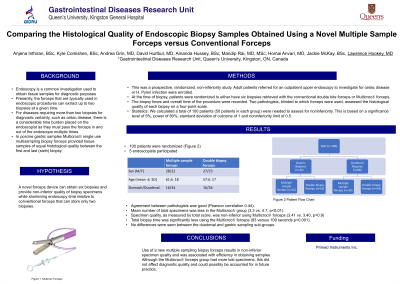Monday Poster Session
Category: General Endoscopy
P1980 - Comparing the Histological Quality of Endoscopic Biopsy Samples Obtained Using a Novel Multiple Sample Forceps vs Conventional Forceps
Monday, October 23, 2023
10:30 AM - 4:15 PM PT
Location: Exhibit Hall

Has Audio

Lawrence Hookey, MD
Gastrointestinal Diseases Research Unit, Queen's University
Kingston, ON, Canada
Presenting Author(s)
Anjena Inthiran, BSc1, Kyle Comishen, BSc1, Andrea Grin, MD1, David Hurlbut, MD2, Amanda Hussey, BSc1, Mandip Rai, MD, MSc1, Homai Anvari, MD1, Jackie McKay, BSc1, Lawrence Hookey, MD1
1Gastrointestinal Diseases Research Unit, Queen's University, Kingston, ON, Canada; 2Gastrointestinal Diseases Research Unit, Kingston, ON, Canada
Introduction: Endoscopy is a common investigation used to obtain tissue samples for diagnostic purposes. Diagnostic certainty requires tissue samples of high quality from multiple sites. Presently, the forceps that are typically used in endoscopic procedures can extract up to two biopsies at a given time. For diseases requiring more than two biopsies for diagnostic certainty, such as celiac disease, there is a considerable temporal burden placed on the endoscopist as they must pass the forceps in and out of the endoscope multiple times. Increases in endoscopy time have been associated with low adherence to diagnostic guidelines. In porcine gastric samples Multicroc® single use multisampling biopsy forceps provided tissue samples of equal histological quality between the first and last (sixth) biopsy. The goal of the present study was to assess whether a novel forceps device that can obtain six biopsies at a given time can provide non-inferior quality of biopsy specimens while shortening endoscopy time relative to conventional forceps that can store only two biopsies.
Methods: This was a prospective, randomized, non-inferiority study. Adult patients referred for an outpatient upper endoscopy to investigate for celiac disease or H. Pylori infection were enrolled. At the time of biopsy, patients were randomized to either have six biopsies retrieved with the conventional double bite forceps or Multicroc® forceps. The biopsy times and overall time of the procedure were recorded. Two pathologists, blinded to which forceps were used, assessed the histological quality of each biopsy on a four-point scale.
Results: 100 patients were randomized (n=68 duodenal and n=32 gastric sampling), with 5 endoscopists participating. Agreement between pathologists was good (Pearson correlation 0.44). Mean number of total specimens was less in the Multicroc® group (3.3 vs. 4.7, p< 0.01). Specimen quality, as measured by total score, was non-inferior using Multicroc® forceps (3.41 vs. 3.40, p=0.9) and total biopsy time was significantly less using the Multicroc® forceps (83 versus 109 seconds p< 0.001). No differences were seen between the duodenal and gastric sampling sub-groups.
Discussion: Use of a new multiple sampling biopsy forceps results in non-inferior specimen quality and was associated with efficiency in obtaining samples. Although the Multicroc® forceps group had more lost specimens, this did not affect diagnostic quality and could possibly be accounted for in future practice.
Disclosures:
Anjena Inthiran, BSc1, Kyle Comishen, BSc1, Andrea Grin, MD1, David Hurlbut, MD2, Amanda Hussey, BSc1, Mandip Rai, MD, MSc1, Homai Anvari, MD1, Jackie McKay, BSc1, Lawrence Hookey, MD1. P1980 - Comparing the Histological Quality of Endoscopic Biopsy Samples Obtained Using a Novel Multiple Sample Forceps vs Conventional Forceps, ACG 2023 Annual Scientific Meeting Abstracts. Vancouver, BC, Canada: American College of Gastroenterology.
1Gastrointestinal Diseases Research Unit, Queen's University, Kingston, ON, Canada; 2Gastrointestinal Diseases Research Unit, Kingston, ON, Canada
Introduction: Endoscopy is a common investigation used to obtain tissue samples for diagnostic purposes. Diagnostic certainty requires tissue samples of high quality from multiple sites. Presently, the forceps that are typically used in endoscopic procedures can extract up to two biopsies at a given time. For diseases requiring more than two biopsies for diagnostic certainty, such as celiac disease, there is a considerable temporal burden placed on the endoscopist as they must pass the forceps in and out of the endoscope multiple times. Increases in endoscopy time have been associated with low adherence to diagnostic guidelines. In porcine gastric samples Multicroc® single use multisampling biopsy forceps provided tissue samples of equal histological quality between the first and last (sixth) biopsy. The goal of the present study was to assess whether a novel forceps device that can obtain six biopsies at a given time can provide non-inferior quality of biopsy specimens while shortening endoscopy time relative to conventional forceps that can store only two biopsies.
Methods: This was a prospective, randomized, non-inferiority study. Adult patients referred for an outpatient upper endoscopy to investigate for celiac disease or H. Pylori infection were enrolled. At the time of biopsy, patients were randomized to either have six biopsies retrieved with the conventional double bite forceps or Multicroc® forceps. The biopsy times and overall time of the procedure were recorded. Two pathologists, blinded to which forceps were used, assessed the histological quality of each biopsy on a four-point scale.
Results: 100 patients were randomized (n=68 duodenal and n=32 gastric sampling), with 5 endoscopists participating. Agreement between pathologists was good (Pearson correlation 0.44). Mean number of total specimens was less in the Multicroc® group (3.3 vs. 4.7, p< 0.01). Specimen quality, as measured by total score, was non-inferior using Multicroc® forceps (3.41 vs. 3.40, p=0.9) and total biopsy time was significantly less using the Multicroc® forceps (83 versus 109 seconds p< 0.001). No differences were seen between the duodenal and gastric sampling sub-groups.
Discussion: Use of a new multiple sampling biopsy forceps results in non-inferior specimen quality and was associated with efficiency in obtaining samples. Although the Multicroc® forceps group had more lost specimens, this did not affect diagnostic quality and could possibly be accounted for in future practice.
Disclosures:
Anjena Inthiran indicated no relevant financial relationships.
Kyle Comishen indicated no relevant financial relationships.
Andrea Grin indicated no relevant financial relationships.
David Hurlbut indicated no relevant financial relationships.
Amanda Hussey indicated no relevant financial relationships.
Mandip Rai indicated no relevant financial relationships.
Homai Anvari indicated no relevant financial relationships.
Jackie McKay indicated no relevant financial relationships.
Lawrence Hookey: astra zeneca – Advisory Committee/Board Member. Pendopharm Canada – Consultant. Primed Canada – Grant/Research Support.
Anjena Inthiran, BSc1, Kyle Comishen, BSc1, Andrea Grin, MD1, David Hurlbut, MD2, Amanda Hussey, BSc1, Mandip Rai, MD, MSc1, Homai Anvari, MD1, Jackie McKay, BSc1, Lawrence Hookey, MD1. P1980 - Comparing the Histological Quality of Endoscopic Biopsy Samples Obtained Using a Novel Multiple Sample Forceps vs Conventional Forceps, ACG 2023 Annual Scientific Meeting Abstracts. Vancouver, BC, Canada: American College of Gastroenterology.
